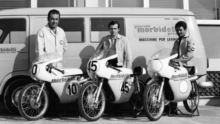Apr. 6, 2009 – Judging the ‘pent-up demand’
VALCOURT, Canada — In wake of big declines in PWC retail sales in 2008, Powersports Business talked to one of the leaders of that market, Sea-Doo, about the possible long-term implications of that decline.
Roch Lambert, vice president and general manager of BRP’s Ski-Doo/Sea-Doo/Evinrude division, discussed last year’s retail sales numbers and what he sees as a key to generating growth in new users in the PWC market.
Lambert discussed these issues during BRP’s recent 50th anniversary event at its Canadian headquarters in Valcourt.
Powersports Business: Sales registration data that Powersports Business has obtained shows the PWC market down 25-plus percent through December of 2008 (year-to-date through December). This comes after consecutive years of
basically flat sales. Is that sales drop in 2008 just a blip — an unfortunate result of the economy — or are there any longer-term concerns that
the market can’t get back to where it was in
previous years?
Roch Lambert: Certainly the economy is tainting all of our numbers today, so it’s difficult to say what drove it. If I compare it with other segments of the powersports industry, I think it’s fair to assume that a lot of that drop this year has been driven by the economy overall. We believe that for all the marine segments, there’s a huge pent-up demand out there. People have been sort of nervous for a couple of years, all the markets have been declining. But I think at the same time, people are just waiting for the opportunity to say, “You know what, my income is safe, my debt is secure, my mortgage is OK, I haven’t lost all of the assets I have.” And I think that when that comfort level comes back, they will come back. So we clearly believe that pent-up demand is there on the personal watercraft side specifically, but on all the products.
Secondly, the early signs on the iControl system are strong. This great innovation, we believe, will bring people to the game. People who may not have the skills to drive a fairly technical personal watercraft. But now, this really makes it accessible for anybody. It’s our job, certainly an interesting challenge, to make sure people know about all the benefits.
Honestly, we believe that we’ll do well if we continue to promote what the new technologies bring — they’re clean, they are smooth, they’re quiet, they’re fuel-efficient.
One of the key messages we have with PWCs is they’re durable. People have this perception that I buy it, it’ll be good for a couple of years, then I’ll throw it away, and you know what, my money is gone. Those things you can use personally for years, and if you want to get rid of it for whatever reason, it will still have a good residual value. And we’ve built that into our marketing tools this year, to say, it is durable, there is a strong residual value to a personal watercraft. But you can enjoy it for years yourself, and you will get your money’s worth out of it.
PSB: We’ve had several of the PWC manufacturers, including Sea-Doo, develop higher horsepower machines, in almost a competition-like atmosphere of who can become horsepower king. How did this part of the market do in the past year? Better or worse than the overall market? And do you see continued OEM concentration on this part of the market?
Lambert: Our numbers, and I would assume the competitive numbers, show there is clearly a migration for more power. I think we’ve all done a great job at growing those segments and expanding on the offerings. Where we all need to challenge ourselves is, how do we bring new people into the game? How do we attract new people to our industry? And I don’t know that it’s natural for everybody to walk in with a fast unit in their heads they want. For some people, it’s intimidating. For a lot of people it’s the thrill, that’s exactly what they want to have — the enthusiasts and the hard-core users.
I think there’s an opportunity for all of us to reflect on how we bring new people to the category and how do we do that efficiently, and bring the people in who wouldn’t view themselves as a client to start with them. But bring them in and let them enjoy the product and then hopefully grow with it.








